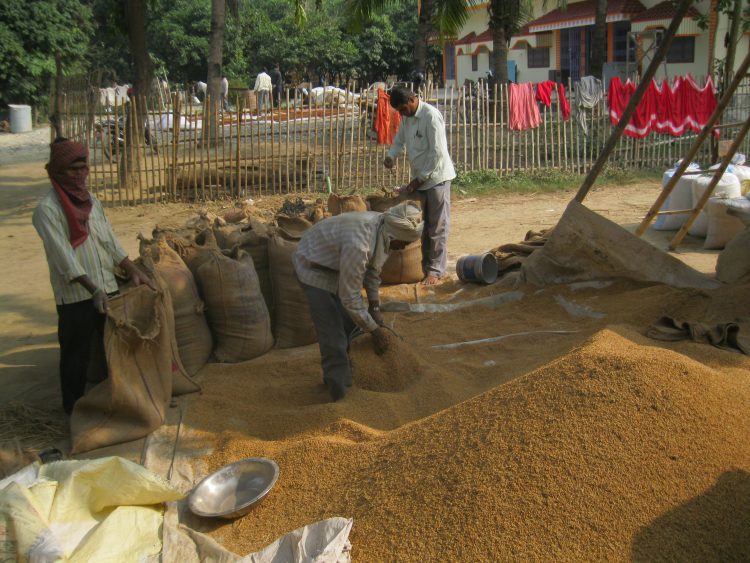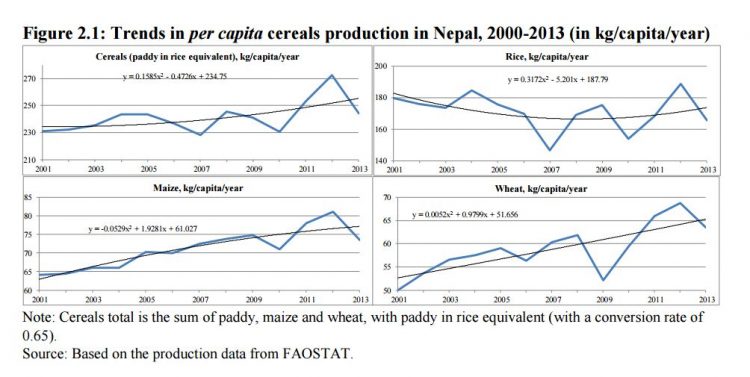Nepal is almost self-reliant in food grain
Sujit Mainali / May 4, 2016

Farmers in a Parsa village filling paddy in gunny sacks in December 2015. Photo: Sujit Mainali
Speaking on a live phone-in program titled “Seedha Kura Pradhanmantrisanga (Direct conversation with the Prime Minister” aired on Nepal Television, Prime Minister KP Oli said that Nepal will be made self-reliant in food grain production within the next two years.
“I am working with a plan to make Nepal self-reliant in food within the next two years,” he said.
South Asia Check has examined whether it is possible.
According to Nepal’s national food balance sheet, food grains including paddy, wheat, maize, millet, oat and buckwheat among others cover the largest portion (40 percent) of the food consumed in Nepal.
After food grains, potato and root crops, vegetables, dairy products, fruits, sugar and honey, meat, nuts, fish, oil, egg, etc are the other major staples.
South Asia Check when attempted to calculate the food quantity needed to make Nepal self-reliant, was unable to find the relevant statistics.
When the available statistics were studied, it was found that Nepal is almost self-sufficient in food grains that cover about 50 percent of the total food consumed in Nepal.
According to the Agricultural Development Strategy-1 prepared by the Ministry of Agricultural Development, the national cereal balance has been more or less in equilibrium, but with deficit in years of inadequate monsoon rainfall.

“Food and Nutrition Security in Nepal: a Status Report” prepared jointly by the Ministry of Agricultural Development (MOAD), Central Bureau of Statistics (CBS) and the Food and Agriculture Organization (FAO) has mentioned that “despite the decade-long insurgency, political instabilities and large-scale outmigration of youths from rural areas, cereal production does not seem to have suffered as much as many in Nepal perceived or speculated.”
Based on these, we can be optimistic that Nepal could be self-reliant in the production of food grains within two years. But it cannot be said whether Nepal could be self-sufficient in overall food production within this period, as claimed by Prime Minister Oli.
This material is copyrighted but may be used for any purpose by giving due credit to southasiacheck.org.
Comments
Latest Stories
- In Public Interest Covid-19 cases are low, but that’s not an excuse to avoid vaccination
- In Public Interest What is BF.7, the sub-variant that has the world by its grip?
- In Public Interest Threat of a new Covid-19 wave looms large amid vaccine shortage in Nepal
- In Public Interest As cases decline, Covid-19 test centres in Kathmandu are desolate lot
- In Public Interest Dengue test fee disparity has patients wondering if they’re being cheated
- In Public Interest As dengue rages on, confusion galore about what it is and what its symptoms are. Here’s what you need to know
In Public Interest
 Covid-19 cases are low, but that’s not an excuse to avoid vaccination
The Pfizer-BioNTech bivalent vaccines authorised by the Nepal Government provide better protection a...
Read More
Covid-19 cases are low, but that’s not an excuse to avoid vaccination
The Pfizer-BioNTech bivalent vaccines authorised by the Nepal Government provide better protection a...
Read More
- What is BF.7, the sub-variant that has the world by its grip?
- Threat of a new Covid-19 wave looms large amid vaccine shortage in Nepal
- As cases decline, Covid-19 test centres in Kathmandu are desolate lot
- Dengue test fee disparity has patients wondering if they’re being cheated
- As dengue rages on, confusion galore about what it is and what its symptoms are. Here’s what you need to know